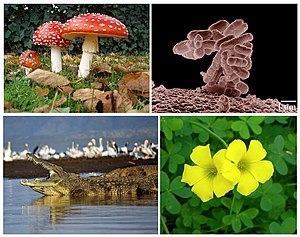Biology

Biology (Greek: βιολογία; from Ancient Greek: Biology) is a Greek surname. βίος "life" + λόγος "teaching, science") is the science of living things and their interaction with their environment. Studies all aspects of life, in particular: the structure, functioning, growth, origin, evolution and distribution of living organisms on Earth. Classifies and describes living things, the origin of their species, the interaction between themselves and with the environment.
As an independent science, biology separated from the natural sciences in the XIX century, when scientists discovered that all living organisms have some common properties and features, in aggregate not characteristic of inanimate nature. The term "biology" was coined independently by several authors: Friedrich Bourdach in 1800, Gottfried Reinhold Treviranus and Jean Baptiste Lamarck in 1802.
Currently, biology is a standard subject in secondary and higher educational institutions around the world. More than a million articles and books on biology, medicine, biomedicine and bioengineering are published annually.
There are five principles that unite all biological disciplines into a single science of living matter:
Cell theory is the study of everything that concerns cells. All living organisms consist of at least one cell, the basic structural and functional unit of organisms. The basic mechanisms and chemistry of all cells in all terrestrial organisms are similar; cells are descended only from pre-existing cells that multiply by cell division. Cell theory describes the structure of cells, their division, interaction with the external environment, the composition of the internal environment and the cell membrane, the mechanism of action of individual parts of the cell and their interaction with each other.
Evolution. Through natural selection and genetic drift, the hereditary traits of a population change from generation to generation.
Gene theory. Traits of living organisms are passed down from generation to generation along with genes that are encoded in DNA. Information about the structure of living beings or genotype is used by cells to create a phenotype, observable physical or biochemical characteristics of the organism. Although the phenotype manifested by gene expression can prepare an organism for life in its environment, information about the environment is not passed back into the genes. Genes can only change in response to environmental influences through an evolutionary process.
Homeostasis. Physiological processes that allow the body to maintain the constancy of its internal environment regardless of changes in the external environment.
Energy. An attribute of any living organism, essential for its condition.
A cell is an elementary structural and functional unit of living organisms. According to the cell theory, all living things consist of one or many cells, or of products of cell secretion, for example: shells, hair, nails. All cells are similar in their chemical composition and general structure. A cell comes only from another mother cell by dividing it, and all the cells of a multicellular organism come from a single fertilized egg. Even the course of pathological processes, such as bacterial or viral infection, depends on the cells that are a fundamental part of them.
The central organizing concept in biology is that life changes and evolves over time through evolution, and that all known forms of life on Earth share a common origin. This led to the similarity of the basic units and processes of vital activity mentioned above. The concept of evolution was introduced into the scientific lexicon by Jean-Baptiste Lamarck in 1809. Charles Darwin established fifty years later that its driving force is natural selection, just as artificial selection is consciously applied by man to create new breeds of animals and plant varieties.[8] Later, in the synthetic theory of evolution, genetic drift was postulated as an additional mechanism of evolutionary change.
The evolutionary history of species, which describes their changes and genealogical relationships among themselves, is called phylogeny. Information about phylogeny is accumulated from different sources, in particular, by comparing DNA sequences or fossil remains and traces of ancient organisms. Until the XIX century, it was believed that under certain conditions life can spontaneously arise. This concept was opposed by the followers of the principle formulated by William Harvey: "all from the egg" (Latin Omne vivum ex ovo), fundamental in modern biology. In particular, this means that there is a continuous line of life connecting the moment of its initial emergence with the present time. Any group of organisms has a common origin if it has a common ancestor. All living things on Earth, both living and extinct, are descended from a common ancestor or a common set of genes. The common ancestor of all living beings appeared on Earth about 3.5 billion years ago. The main proof of the theory of a common ancestor is the universality of the genetic code.
- Arts
- Business
- Computers
- Jocuri
- Health
- Home
- Kids and Teens
- Money
- News
- Recreation
- Reference
- Regional
- Science
- Shopping
- Society
- Sports
- Бизнес
- Деньги
- Дом
- Досуг
- Здоровье
- Игры
- Искусство
- Источники информации
- Компьютеры
- Наука
- Новости и СМИ
- Общество
- Покупки
- Спорт
- Страны и регионы
- World


